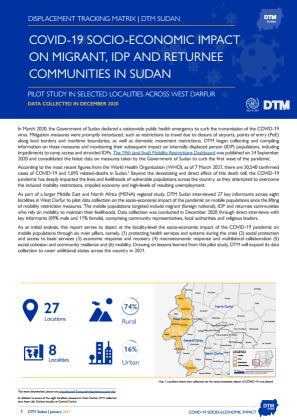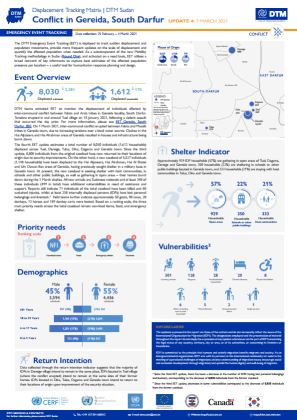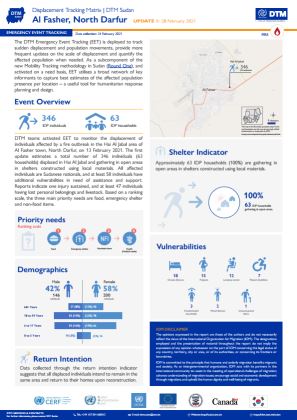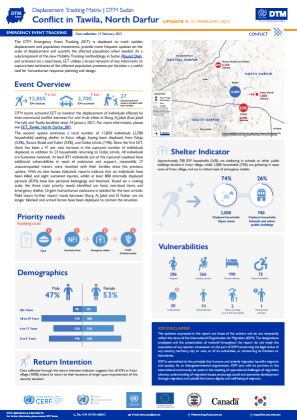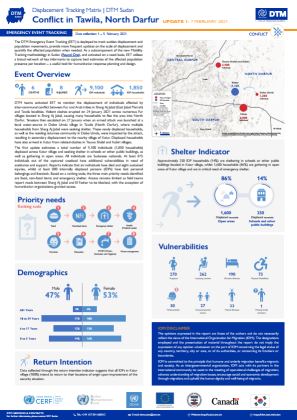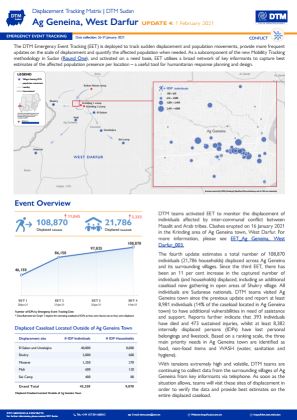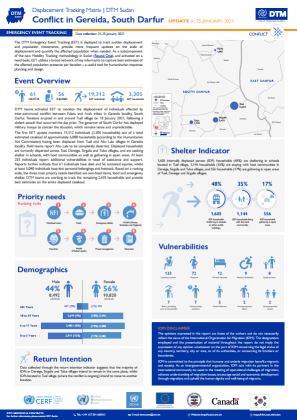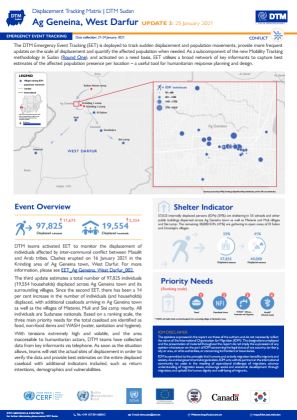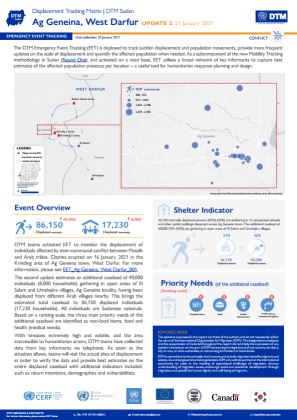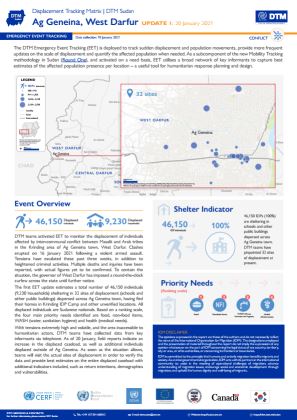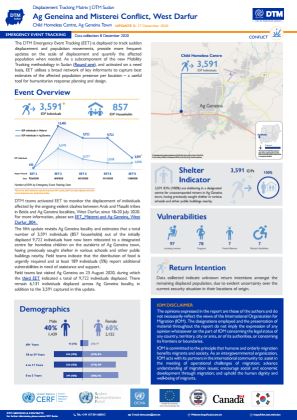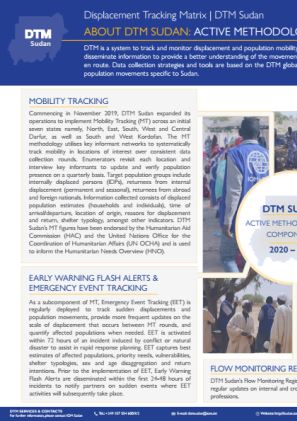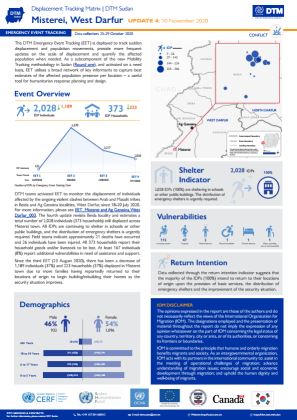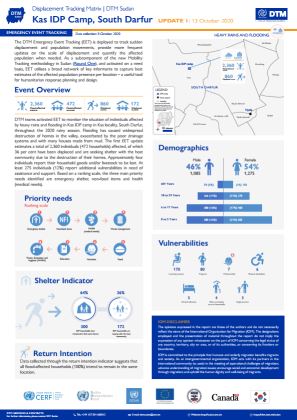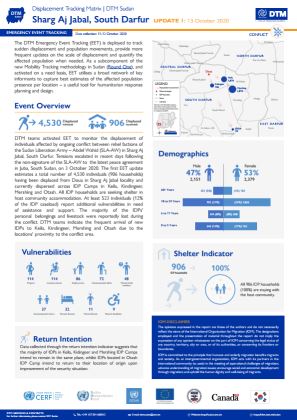-
Countries
-
Data and Analysis
-
Special Focus
-
Crisis Responses
Sudan
IDPs registered
Displacement Movements
3,553,000
IDMC 2022
Data collection round
About Sudan
DTM is a system to track and monitor displacement and population mobility. It is designed to regularly and systematically capture, process and disseminate information to provide a better understanding of the movements and evolving needs of displaced populations, whether on site or en route. Data collection strategies and tools are based on the DTM global methodology but have been adapted to reflect the context and population movements specific to Sudan.
In order to appraise the humanitarian community with primary data on displacement caseloads and dynamics, DTM currently employs over 300 field enumerators to engage with its wide key informant network spanning all of Sudan’s 18 states. Enumerators are employed based on their prior knowledge of their areas of concern, and are trained on DTM Sudan’s global data collection standard and methodologies. To stay up-to-date with DTM’s outputs, please join our mailing list here.
Since 2004, DTM Sudan has provided rapid emergency registrations with a priority of meeting immediate information needs for guiding direct assistance to vulnerable people. In 2010, DTM expanded to include biometric registrations and data verifications – implemented in response to government or humanitarian partner requests. Registration data is mission critical for site managers to undertake beneficiary selection, vulnerability targeting, and to inform broader humanitarian programming. Additionally, DTM Sudan is has operated one Flow Monitoring Point at Abyei – registering the arrival of South Sudanese into the country.
Commencing in November 2019, DTM Sudan expanded its operations to implement Mobility Tracking (MT) across an initial seven states – expanding to reach a total of 17 states (as of Round Six). The MT methodology utilises key informant networks to systematically track mobility in locations of interest over consistent data collection rounds. Enumerators revisit each location and interview key informants to update locations and periodically verify population presence. DTM Sudan’s MT figures have been endorsed by the Humanitarian Aid Commission (HAC) and coordinated with UNOCHA, and is used to inform the Humanitarian Needs Overview (HNO) and Humanitarian Response Plan.
As a subcomponent of Mobility Tracking, Emergency Event Tracking (EET) is regularly deployed to track sudden displacements and population movements and provide more frequent updates when needed. EET is activated within 72 hours – one week after an event (such as natural disasters or conflict) to assist in rapid response planning. Prior to the implementation of EET, Early Warning Flash Alerts are disseminated within the first 24-48 hours of incidents to notify partners on sudden events where EET activities will subsequently take place. Additionally, DTM Sudan has designed Situation Assessments to collect data on populations in non-emergency settings or protracted situations caused by conflict or natural disaster.
Alongside the Mobility Tracking methodology, DTM has conducted Integrated Location Assessments (ILA). ILAs are utilised to enhance and provide accurate and up-to-date information on access to services at major sites of displacement, alongside profiles of displaced and returnee populations. The purpose of these exercises is to determine a severity level of living conditions of returnees and IDPs to allow partners to better strategize for resources and operations in vulnerable areas or to mitigate risks of push/pull factors for a more specific set of coherent interventions that bridge humanitarian, recovery, and stabilisation needs.
DTM has also supported data collection on the Multi-Sector Needs Assessment (MSNA). The MSNA aims to assess and provide timely update on sectoral humanitarian needs of populations across Sudan. In previous years, the MSNA provided an overview of the sectoral needs of IDP and non-displaced populations to inform humanitarian response and strategic programming. The MSNA is also the central component of providing a sound evidence base for the Humanitarian Needs Overview and Humanitarian Response Plan. The MSNA is completed in close coordination with UNOCHA, the Inter-Sector Coordination Group, and the National Assessment Task Team. Since 2021, DTM Sudan has typically conducted the MSNA on an annual basis in coordination with partners in the humanitarian community.
Since the onset of the military conflict between the Sudanese Armed Forces (SAF) and the Rapid Support Forces (RSF) commencing 15 April 2023, DTM Sudan has provided the humanitarian community with comprehensive updates on displacement trends observed as a direct result of the fighting. Six months following the conflict, DTM Sudan has observed IDPs in 167 of Sudan’s 189 localities, across all 18 states. Commencing with Situation Reports, and then becoming Weekly Displacement Snapshots, these reports also provide information on mixed-cross border flows to neighbouring countries. In these reports, DTM utilises a key informant methodology to capture best estimates of IDP caseloads, shelter typologies, and movement intentions. This information is gathered via dual combination of remote and face-to-face interviews. The Monthly Displacement Overview – which includes a greater contextual analysis including sex and age disaggregation, priority needs, and access to services at IDP locations.
For further information, please contact IOM Sudan:
- Tel.: +249 157 554 600/1/2
- Email: dtmsudan@iom.int
Current Donors
- USAID
- ECHO
Sudan – Emergency Event Tracking Report Saraf Omra, North Darfur 001
DTM teams activated Emergency Event Tracking (EET) to monitor the displacement of individuals affected by violent clashes between Fur and Al-Tama tribes in Saraf Omra town, North Darfur, on 3 March 2021.
Sudan — COVID-19 Socio-Economic Impact on Migrant, IDP and Returnee Communities Pilot Study
As part of a larger Middle East and North Africa (MENA) regional study, DTM Sudan interviewed 27 key informants across eight localities in West Darfur to pilot data collection on the socio-economic impact of the pandemic on mobile populations since the lifting of mobility restriction measures.
Sudan – Emergency Event Tracking Report Gereida, South Darfur 004
DTM teams activated Emergency Event Tracking (EET) to monitor the displacement of individuals affected by inter-communal conflict between Falata and Arab tribes in Gereida locality, South Darfur.
Sudan – Emergency Event Tracking Report Ag Geneina, West Darfur 008 (2021)
DTM teams activated Emergency Event Tracking (EET) to monitor the displacement of individuals affected by inter-communal conflict between Masalit and Arab tribes. Clashes erupted on 16 January 2021 in the Krinding area of Ag Geneina town, West Darfur.
Sudan — Emergency Event Tracking Report Al Fasher, North Darfur 001
DTM teams activated Emergency Event Tracking (EET) to monitor the displacement of individuals affected by a fire outbreak in the Hai Al Jabal area of Al Fasher town, North Darfur, on 13 February 2021.
Sudan – Emergency Event Tracking Report Ag Geneina, West Darfur 007 (2021)
DTM teams activated Emergency Event Tracking (EET) to monitor the displacement of individuals affected by inter-communal conflict between Masalit and Arab tribes.
Sudan – Emergency Event Tracking Report Tawila, North Darfur 002
DTM teams activated Emergency Event Tracking (EET) to monitor the displacement of individuals affected by inter-communal conflict between Fur and Arab tribes in Sharg Aj Jabal (East Jabal Marrah) and Tawila localities since 24 January 2021. The second update estimates a total number of 12,850 ind
Emergency Event Tracking Report Ag Geneina, West Darfur 005 (2021)
DTM teams activated Emergency Event Tracking (EET) to monitor the displacement of individuals affected by inter-communal conflict between Masalit and Arab tribes.
Emergency Event Tracking Report Gereida, South Darfur 003
DTM teams activated Emergency Event Tracking (EET) to monitor the displacement of individuals affected by inter-communal conflict between Falata and Arab tribes in Gereida locality, South Darfur.
Emergency Event Tracking Report Gereida, South Darfur 002
DTM teams activated Emergency Event Tracking (EET) to monitor the displacement of individuals affected by inter-communal conflict between Falata and Arab tribes in Gereida locality, South Darfur.
Emergency Event Tracking Report Ag Geneina, West Darfur 004 (2021)
DTM teams activated Emergency Event Tracking (EET) to monitor the displacement of individuals affected by inter-communal conflict between Masalit and Arab tribes. Clashes erupted on 16 January 2021 in the Krinding area of Ag Geneina town, West Darfur.
Emergency Event Tracking Report Gereida, South Darfur 001
DTM teams activated Emergency Event Tracking (EET) to monitor the displacement of individuals affected by inter-communal conflict between Falata and Arab tribes in Gereida locality, South Darfur.
Emergency Event Tracking Report Ag Geneina, West Darfur 003 (2021)
DTM teams activated Emergency Event Tracking (EET) to monitor the displacement of individuals affected by inter-communal conflict between Masalit and Arab tribes. Clashes erupted on 16 January 2021 in the Krinding area of Ag Geneina town, West Darfur.
Emergency Event Tracking Report Ag Geneina, West Darfur 002 (2021)
DTM teams activated Emergency Event Tracking (EET) to monitor the displacement of individuals affected by inter-communal conflict between Masalit and Arab tribes. Clashes erupted on 16 January 2021 in the Krinding area of Ag Geneina town, West Darfur.
Emergency Event Tracking Report Ag Geneina, West Darfur 001 (2021)
DTM teams activated EET to monitor the displacement of individuals affected by inter-communal conflict between Masalit and Arab tribes in the Krinding area of Ag Geneina town, West Darfur. Clashes erupted on 16 January 2021 following a violent armed assault.
Emergency Event Tracking Report Ag Geneina and Misterei Conflict, West Darfur 005
DTM teams activated Emergency Event Tracking (EET) to monitor the displacement of individuals affected by the ongoing violent clashes between Arab and Masalit tribes in Beida and Ag Geneina localities, West Darfur, since 18-20 July 2020.
DTM Sudan — Active Methodological Components 2020 - 2021
DTM is a system to track and monitor displacement and population mobility.
Emergency Event Tracking Report Misterei, West Darfur 004
DTM teams activated Emergency Event Tracking (EET) to monitor the displacement of individuals affected by the ongoing violent clashes between Arab and Masalit tribes in Beida and Ag Geneina localities, West Darfur, since 18-20 July 2020.
Sudan — Registration and Flow Monitoring Quarterly Overview (July - September 2020)
From July to September 2020, IOM’s Displacement Tracking Matrix (DTM) conducted a total of 12,316 registrations in Sudan – 95 per cent of which were internally displaced persons (IDPs) and five per cent returnees from internal displacement.
Emergency Event Tracking Report Kas IDP Camp, South Darfur 001
The DTM Emergency Event Tracking (EET) is deployed to track sudden displacement and population movements, and provide more frequent updates on the scale of displacement and quantify the affected population when needed.
Emergency Event Tracking Report Sharg Aj Jabal, South Darfur 001
The DTM Emergency Event Tracking (EET) is deployed to track sudden displacement and population movements, and provide more frequent updates on the scale of displacement and quantify the affected population when needed.
Pagination
Pagination
- First page
- Previous page
- 1
- 2
- 3
- 4
- 5



